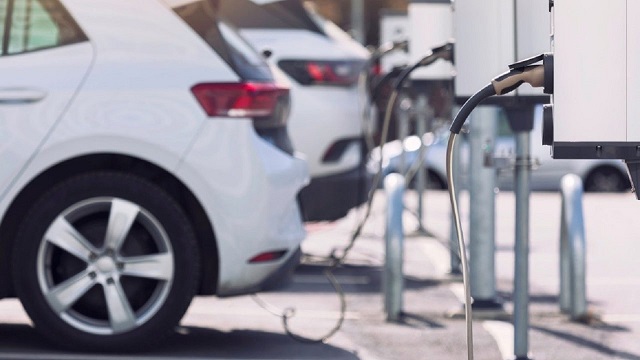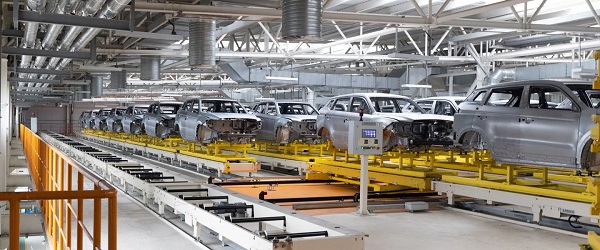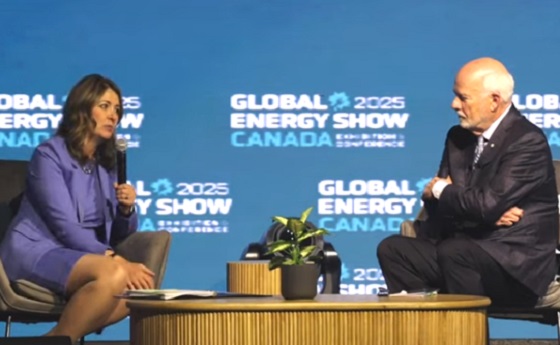Automotive
Energy Notes From the Edge: EV Industry on Limp-Home Mode; Greenpeace’s Firehose Used Against Them and They’re Not Happy

From the Frontier Centre for Public Policy
By Terry Etam
Consumers have spoken, auto makers are responding, and the odd man out are governments still paralyzed in 2019 when euphoric and nonsensical “environmental” policy danced on the supposed grave of last century’s fuel.
Summer was pretty quiet, thankfully, but time for a jolt to get reengaged. There’s no better way than getting yelled at, so today let’s talk about a surefire recipe – Electric Vehicles. Those that love EVs really love ‘em, and to speak ill of them in front of the fans is akin to asking questions about the size of their children’s ears.
EVs have an outsized role in the current cultural and economic landscape, in an odd way. They are seen as the best hope to turn the tide of general consumer emissions. Governments threw their full weight behind them to an astonishing degree, legislating them into projected dominance at an unprecedented (and as it turns out, insane) pace.
What makes EVs such a flashpoint is that they intersect with a bunch of stuff that people hold dear. For some, EV ownership feels like a major personal contribution to the global emissions problem, if owning one entails a significant personal commitment. For many, EVs make total sense if only running around town, or if wealthy enough to keep one in the garage amongst the Astons and Ferraris so as to be well-positioned to make an environmental statement if required. Some love them for their simplicity, with few moving parts and lower maintenance requirements (lower, but not zero). Still others love them because they can fuel up at home, at night. And then there is the cohort that feels their rage against oil companies sated cathartically every time they drive past a gas station, those that believe hydrocarbons bring nothing but death, irrespective of the fact that to that point in their life they’ve brought them everything within their purview, including all the things that keep them alive. Have pity on those people, the neutron-level boxing matches going on between their ears are not to be wished on anyone.
On the flip side of the equation, and what brings it to the news, is the public’s general feeling of “meh” towards them, the 80 percent that constitutes the non-extreme middle. In sane times, that is not a problem; major change happens gradually for such big ticket items, and most get a sense that certain segments of the economy work extremely well as EVs – delivery fleet vehicles, forklifts, urban taxis, etc. Many would drift toward EVs as battery technology improves, as range increases, as price falls. But such a shift would be a multi-generational thing, particularly with the infrastructure changes required.
Most consumers can see that that Total And Rapid EV Domination is not a particularly wise vision, even if governments have declared that that must happen within their dog’s lifespan.
Consumers do know a good idea when they see one, and we can see that by the explosion in popularity of hybrid vehicles – those with internal combustion engines augmented by modest battery packs and electric motors that give a certain emissions-free range before switching to gasoline power.
There’s a reason for this growing popularity – it makes sense on many levels. A hybrid removes some of the major reasons people are reluctant to go full-battery EV (BEV) – range anxiety, cold weather performance, etc. – and, as Toyota has wisely pointed out, hybrids are actually better for the environment in general than mass consumer adoption of EVs.
How can that be, you might wonder. Here is Toyota’s calculation, in what they call the 1:6:90 rule. An excellent write up can be found here, and the gist of it is: Because of immense challenges in finding, developing, mining, and processing critical metals and minerals (hundreds of new mines required globally, with each new mine having weaker grades than before, and with many jurisdictions becoming more hostile towards new mines), it makes more sense to utilize a given BEV’s minerals requirements to construct 90 hybrids instead.
Because many trips are very short, a hybrid can run on electric power for most of them, which is how the spreading-out of these minerals to many vehicles makes emissions reduction sense. Toyota calculates that if the metals/minerals used to construct a single EV were instead used to build 90 hybrids, the overall carbon reduction from those hybrids over their lifetimes would be 37 times that of a single EV (and with that sentence, I don my helmet for the incoming shouts of “Fossil Fuel Shill” – the aforementioned yelling).
Customers are clamouring to acquire hybrids. According to a Car Dealership Guy article (excellent auto news site, from a dealer perspective), in August, 48 percent of Toyota sales were hybrids, Hyundai had an 81 percent increase in hybrids (albeit from a relatively smaller number than Toyota), and Ford saw hybrid sales increase by 50 percent.
Volvo, a company that had pledged to be completely EV by 2030 and thereby banishing the smell of gasoline forevermore from customers’ nostrils, recently backed down from that pledge to announced hybrids would remain part of the equation indefinitely. “Everybody made a lot of assumptions two, three, four, five years ago, and that’s changed,” said Volvo’s CEO.
And then there is the Chinese onslaught of affordable, high-quality EVs that somehow policy planners didn’t see coming. Western countries announced bans on ICE in favour of full-EV by the next decade, and lo and behold, China controls most elements of an EV’s composition, and they took full advantage of that supply chain dominance (plus massive government support) to undercut virtually every western EV maker. Hey, you can’t do that, said US, Canadian, and EU governments, slapping huge tariffs on Chinese made EVs because well, we want to save the environment but not that badly (ultra cheap EVs are one of the few catalysts that would accelerate wide spread and rapid EV adoption among the masses).
Not sure where this goes next. Consumers have spoken, auto makers are responding, and the odd man out are governments still paralyzed in 2019 when euphoric and nonsensical “environmental” policy danced on the supposed grave of last century’s fuel. How they backpedal out of this is anyone’s guess, although there are signs, such as this headline: “Italy leads revolt against Europe’s electrical vehicle transition”. If memory serves from Italian traffic, they seem fine with virtually any sort of vehicular madness, so a automotive revolt in that land is a pretty big deal.
As with so, so many aspects of an energy transition, if the whole process had not been hijacked by zealots, we would be farther down the road, we would have consumers on side, we would have entire industries functioning properly instead of the fiascos we in for example the auto industry, and we most likely would have far less emissions.
Greenpeace USA on the ropes
In the big scheme of things, seeing something that has the words “green” and “peace” in the name fail would be disheartening; no sane person is against either the environment or peace. But put those two words together and you have something else entirely.
In the US, Greenpeace is for once holding the crappy end of the stick that they are used to jabbing at everything they disagree with. US energy pipeline giant Energy Transfer is seeking $300 million in damages for Greenpeace’s role in delaying the Dakota Access Pipeline. An ET victory would and should send shockwaves through the massively well financed protest industry that so far employs every tactic in the book to achieve victory (and by ‘victory’ we generally means ‘obstruction’ or ‘vengeance’ as opposed to any sort of constructive advancement). The big ENGOs spend hundreds of millions on staff and lawyers who literally have nothing to do other than bend society to their will without the bothersome hassle of going through the democratic process. Robert Bryce’s excellent Substack column keeps track of the staggering sums that US ENGOs churn through; Greenpeace US is a pipsqueak ($33 million annual engorgement) compared to locust-lawyer Natural Resources Defense Council’s staggering $548 million. With all that money, these groups construct nothing.)
It is a surprise there haven’t been more of these lawsuits filed by thwarted companies and hydrocarbon producers dragged into court for the sin of providing the fuel that keeps us all alive. It’s really not a hard argument to make; the world as we know it will collapse without hydrocarbon production, so shouldn’t thwarting that production on sometimes very flimsy grounds count for something? Shouldn’t blocking fuel from consumers that desperately need it (countless pipeline battles) count for something?
Greenpeace’s defence is pretty funny; suddenly they are insignificant, claiming to have had only a supporting role in the protests, and that the lawsuit is, the funniest part, an “attack on free speech.” Chaining one’s self (or worse, sending some naive acolyte to chain their selves) to a bulldozer on a construction site is, apparently, ‘free speech’, as is law fare and endless slanderous comments about the people and businesses that bring them the fuel that keeps their unhappy lives going.
Maybe the resurrected body, of which you can be certain will appear if this one is bankrupted, should start off with a bit of soul searching. Maybe peace means everyone working together for a common goal, not dramatizing a villain as the means of motivating the troops. Maybe ‘green’ should mean concern for habitat, concern for air pollution, concern for more intelligent use of resources, concern for the most logical global approach to progress, as opposed to a singular war against the bedrock of our society that it is glaringly obvious we cannot and will not live without.
First published here.
Terry Etam is a columnist with the BOE Report, a leading energy industry newsletter based in Calgary. He is the author of The End of Fossil Fuel Insanity. You can watch his Policy on the Frontier session from May 5, 2022 here.
Automotive
Canada’s EV house of cards is close to collapsing

 By Dan McTeague
By Dan McTeague
Well, Canada’s electric vehicle policies are playing out exactly as I predicted. Which is to say, they’re a disaster.
Back in November, in the immediate aftermath of Donald Trump’s re-election, I wrote in these pages that, whatever else that election might mean for Canada, it would prove big trouble for the Justin Trudeau/Doug Ford EV scam.
The substance of their plot works like so: first, the federal and provincial governments threw mountains of taxpayer dollars in subsidies at automakers so that they’d come to Canada to manufacture EVs. Then Ottawa mandated that Canadians must buy those EVs — exclusively — by the year 2035. That way Ford and Trudeau could pat themselves on the back for “creating jobs,” while EV manufacturers could help themselves to the contents of our wallets twice over.
But the one variable they didn’t account for was a return of Donald Trump to the White House.
Trump had run on a promise to save America from their own back-door EV mandates. Though Kamala Harris had denied that any such mandates existed, they did, and they were founded on two acts of the Biden-Harris administration.
First, they issued an Executive Order setting significantly more onerous tailpipe regulations on all internal combustion engine (ICE) vehicles, with the explicit goal of ensuring that 50 percent of all new vehicles sold in America be electric by 2030.
Second, they granted California a waiver to make those regulations more burdensome still, so that only EVs could realistically be in compliance with them. Since no automaker would want to be locked out of the market of the most populous state, nor could they afford to build one set of cars for California (plus the handful of states which have — idiotically — chosen to align their regulations with California’s) and another set for the rest of the country, they would be forced to increase their manufacture and sale of EVs and decrease their output of ICE vehicles.
Trump’s victory took Canada’s political class completely by surprise, and it threw a spanner into the workings of the Liberals’ plan.
That’s because there just aren’t enough Canadians, or Canadian tax dollars, to make their EV scheme even kinda’ work. Canada’s unique access to the world’s biggest market — America — was a key component of the plan.
After all, vehicles are “the second largest Canadian export by value, at $51 billion in 2023, of which 93 percent was exported to the US,” according to the Canadian Vehicle Manufacturers Association, and “Auto is Ontario’s top export at 28.9 percent of all exports (2023.)”
It further depended on Americans buying more and more EVs every year. But since, when given a choice, most people prefer the cost and convenience of ICE vehicles, this would only work if Americans were pushed into buying EVs, even if in a more roundabout way than they’re being forced on Canadians.
Which is why the plan all began to unravel on January 20, the day of Trump’s inauguration, when he signed Executive Order 14154, “Unleashing American Energy,” which, among other things, rescinded Joe Biden’s pro-EV tailpipe regulations. And it has continued downhill from there.
Just last week, the US Senate voted to repeal the Biden EPA’s waiver for California. Not that that’s the end of the story — in the aftermath of the vote, California governor Gavin Newsom vowed “to fight this unconstitutional attack on California in court.” (Though don’t be surprised if that fight is brief and half-hearted — Newsom has been trying to leave his lifelong leftism behind recently and rebrand as a moderate Democrat in time for his own run at the White House in 2028. Consequently, being saved from his own EV policy might only help his career prospects going forward.)
But it’s worth noting the language used by the Alliance for Automotive Innovation, which represents car companies like Toyota, GM, Volkswagen and Stellantis (several of whom, it should be noted, have received significant subsidies from the Liberal and Ford governments to manufacture EVs), which said in a statement, “The fact is these EV sales mandates were never achievable.”
That’s worth repeating: these EV sales mandates were never achievable!
That’s true in California, and it’s true in Canada as well.
And yet, our political class has refused to accept this reality. Doug Ford actually doubled down on his commitment to heavily subsidizing the EV industry in his recent campaign, saying “I want to make it clear… a re-elected PC government will honour our commitment to invest in the sector,” no matter what Donald Trump does.
Except, as noted above, Donald Trump represents the customers Doug Ford needs!
Meanwhile, our environmentalist-in-chief, Mark Carney, has maintained the Liberal Party’s commitment to the EV mandates, arguing that EVs are essential for his vacuous plan of transforming Canada into a “clean energy superpower.” How exactly? That’s never said.
These are the words of con artists, not men who we should be trusting with the financial wellbeing of our country. Unfortunately, in our recent federal election — and the one in Ontario — this issue was barely discussed, beyond an 11th-hour attempted buzzer-beater from Pierre Poilievre and a feeble talking point from Bonnie Crombie about her concern “that the premier has put all our eggs in the EV basket.”
Meanwhile, 2035 is just around the corner.
So we can’t stop calling attention to this issue. In fact, we’re going to shout about our mindless EV subsidies and mandates from the rooftops until our fellow Canadians wake up to the predicament we’re in. It took some time, but we made them notice the carbon tax (even if the policy change we got from Carbon Tax Carney wasn’t any better.) And we can do it with electric vehicles, too.
Because we don’t have the money, either as a nation or as individuals, to prop this thing up forever.
Dan McTeague is President of Canadians for Affordable Energy.
Automotive
EV fantasy losing charge on taxpayer time

From the Fraser Institute
By Kenneth P. Green
The vision of an all-electric transportation sector, shared by policymakers from various governments in Canada, may be fading fast.
The latest failure to charge is a recent announcement by Honda, which will postpone a $15 billion electric vehicle (EV) project in Ontario for two years, citing market demand—or lack thereof. Adding insult to injury, Honda will move some of its EV production to the United States, partially in response to the Trump Tariff Wars. But any focus on tariffs is misdirection to conceal reality; failures in the electrification agenda have appeared for years, long before Trump’s tariffs.
In 2023, the Quebec government pledged $2.9 billion in financing to secure a deal with Swedish EV manufacturer NorthVolt. Ottawa committed $1.34 billion to build the plant and another $3 billion worth of incentives. So far, per the CBC, the Quebec government “ invested $270 million in the project and the provincial pension investor, the Caisse de dépôt et placement du Québec (CDPQ), has also invested $200 million.” In 2024, NorthVolt declared bankruptcy in Sweden, throwing the Canadian plans into limbo.
Last month, the same Quebec government announced it will not rescue the Lion Electric company from its fiscal woes, which became obvious in December 2024 when the company filed for creditor protection (again, long before the tariff war). According to the Financial Post, “Lion thrived during the electric vehicle boom, reaching a market capitalization of US$4.2 billion in 2021 and growing to 1,400 employees the next year. Then the market for electric vehicles went through a tough period, and it became far more difficult for manufacturers to raise capital.” The Quebec government had already lost $177 million on investments in Lion, while the federal government lost $30 million, by the time the company filed for creditor protection.
Last year, Ford Motor Co. delayed production of an electric SUV at its Oakville, Ont., plant and Umicore halted spending on a $2.8 billion battery materials plant in eastern Ontario. In April 2025, General Motors announced it will soon close the CAMI electric van assembly plant in Ontario, with plans to reopen in the fall at half capacity, to “align production schedules with current demand.” And GM temporarily laid off hundreds of workers at its Ingersoll, Ontario, plant that produces an electric delivery vehicle because it isn’t selling as well as hoped.
There are still more examples of EV fizzle—again, all pre-tariff war. Government “investments” to Stellantis and LG Energy Solution and Ford Motor Company have fallen flat and dissolved, been paused or remain in limbo. And projects for Canada’s EV supply chain remain years away from production. “Of the four multibillion-dollar battery cell manufacturing plants announced for Canada,” wrote automotive reporter Gabriel Friedman, “only one—a joint venture known as NextStar Energy Inc. between South Korea’s LG Energy Solution Ltd. and European automaker Stellantis NV—progressed into even the construction phase.”
What’s the moral of the story?
Once again, the fevered dreams of government planners who seek to pick winning technologies in a major economic sector have proven to be just that, fevered dreams. In 2025, some 125 years since consumers first had a choice of electric vehicles or internal combustion vehicles (ICE), the ICE vehicles are still winning in economically-free markets. Without massive government subsidies to EVs, in fact, there would be no contest at all. It’d be ICE by a landslide.
In the face of this reality, the new Carney government should terminate any programs that try to force EV technologies into the marketplace, and rescind plans to have all new light-duty vehicle sales be EVs by 2035. It’s just not going to happen, and planning for a fantasy is not sound government policy nor sound use of taxpayer money. Governments in Ontario, Quebec and any other province looking to spend big on EVs should also rethink their plans forthwith.
-

 conflict2 days ago
conflict2 days agoIran nuclear talks were ‘coordinated deception’ between US and Israel: report
-

 Alberta2 days ago
Alberta2 days agoPunishing Alberta Oil Production: The Divisive Effect of Policies For Carney’s “Decarbonized Oil”
-

 International2 days ago
International2 days agoIsrael’s Decapitation Strike on Iran Reverberates Across Global Flashpoints
-

 Energy2 days ago
Energy2 days agoCanada is no energy superpower
-

 Health2 days ago
Health2 days agoJust 3 Days Left to Win the Dream Home of a Lifetime!
-

 Alberta2 days ago
Alberta2 days agoAlberta Premier Danielle Smith Discusses Moving Energy Forward at the Global Energy Show in Calgary
-

 Fraser Institute2 days ago
Fraser Institute2 days agoLong waits for health care hit Canadians in their pocketbooks
-

 conflict1 day ago
conflict1 day agoOne dead, over 60 injured after Iranian missiles pierce Iron Dome




